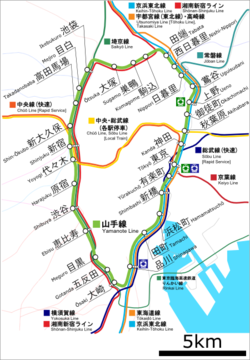Yamanote Line
| Yamanote Line | |||
|---|---|---|---|

Yamanote Line E235 series EMU
|
|||
| Overview | |||
| Native name | 山手線 | ||
| Type | Heavy rail | ||
| Locale | Tokyo | ||
| Termini | Shinagawa (loop) | ||
| Stations | 29 | ||
| Daily ridership | 1,097,093 (daily 2015) | ||
| Operation | |||
| Opened | 1885 | ||
| Operator(s) |
|
||
| Depot(s) | Tokyo General Rolling Stock Centre (near Ōsaki Station) | ||
| Rolling stock | E231-500 series, E235 series | ||
| Technical | |||
| Line length | 34.5 km (21.4 mi) | ||
| Number of tracks | 2 | ||
| Track gauge | 1,067 mm (3 ft 6 in) | ||
| Electrification | 1,500 V DC overhead line | ||
| Operating speed | 90 km/h (55 mph) | ||
|
|||
The Yamanote Line (山手線 Yamanote-sen?) is a railway loop line in Tokyo, Japan, operated by East Japan Railway Company (JR East). It is one of Tokyo's busiest and most important lines, connecting most of Tokyo's major stations and urban centres, including Marunouchi, the Yūrakuchō/Ginza area, Shinagawa, Shibuya, Shinjuku, Ikebukuro and Ueno, with all but two of its 29 stations connecting to other railway or underground (subway) lines.
As an official line name, "Yamanote Line" indicates the tracks between Shinagawa and Tabata via Shinjuku that are used by local trains on their own tracks as well as the parallel Yamanote Freight Line which is used by Saikyō Line and Shōnan-Shinjuku Line trains, some limited express services, and freight trains. However, in everyday usage the "Yamanote Line" refers to the entire 34.5 km loop line served by local trains. (This article uses the same definition unless noted otherwise.)
Trains run from 04:26 to 01:18 the next day at intervals as short as 2.5 minutes during peak periods and four minutes at other times. A complete loop takes 59 to 65 minutes. All trains stop at each station. Trains are put into and taken out of service at Ōsaki (which for timetabling purposes is the line's start and terminus) and sometimes Ikebukuro. Certain trains also start from Tamachi in the mornings and end at Shinagawa in the evenings. Trains which run clockwise are known as sotomawari (外回り?, "outer circle") and those counter-clockwise as uchi-mawari (内回り?, "inner circle"). (Trains travel on the left in Japan, as with road traffic.)
...
Wikipedia

